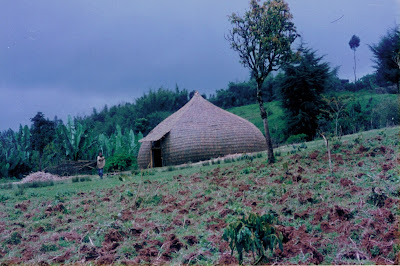So after several hours
on the road we came to the turnoff that would take us across the river and to
the FH/E project site at Cheha. These days there’s a Wikipedia page with all
kinds of information about Cheha, but back then we had to learn everything on
the fly.
Cheha is a woreda or
administrative district located in the Gurage Zone of Ethiopia. The zone is
named for the Gurage (pronounced “goo-rah-gay”) people whose homeland it is.
Remember how I mentioned that there are dozens of different people groups and
languages in Ethiopia? As of 2007 there were about 1.8 million Gurage people in
all of Ethiopia, about 2.3% of the total population. Cheha is home to about
116,000 people of whom 99% are Gurage (and those numbers haven’t changed much
since the 1994 census, right before we got there).
Like most folks in rural Ethiopia, the Gurage people are subsistence farmers. Their staple food and primary crop is enset, also known as false banana because the trees resemble each other. But unlike the delectable banana, enset (the food) is derived from the root of enset (the tree) by pounding it into a paste and fermenting it in a pit – to make it “more palatable” – before it’s baked into bland starchy bread or cooked into bland starchy porridge. According to Wikipedia, the fermented paste can be stored for several years (!!!) and people tend to maintain a supply just in case. Also according to Wikipedia, someone has actually studied the central role enset plays in the lives of the Gurage and other peoples in the so-called “Enset Culture Complex” of southwestern Ethiopia. Hunh, who knew?
The Gurage people also
raise livestock, and in particular Zebu (aka Brahman) cattle, which you will
recognize by their distinctive shoulder hump. The cattle are raised for their
milk, which is mostly made into butter; the Gurage spice it and age it and use
it for a variety of medicinal purposes. Milk is rarely drunk plain but is also
used to make a kind of sour cottage cheese that’s eaten along with the enset
porridge.
We had already seen
tukuls (“too-kuls”) in and around Addis Abeba – these are the traditional
round, one-room homes of rural Ethiopians, with walls made of wattle-and-daub,
and thatched roofs. So we were impressed to see the Gurage version, which is
more like a giant basket for living: woven from the tip of the roof all the way
down to ground level. (And probably made from enset fronds, now that I think
about it. In this photo, you can see an enset tree just behind the tukul, to the left of the doorway).
As in a more traditional
tukul, a portion of this home would be walled off to accommodate the family’s
livestock under the same roof.
And what, you may ask,
was FH/Ethiopia doing in this seemingly lush and relatively prosperous neighborhood? Well, the
goal was to make sure that people didn’t suffer and die from preventable
causes. To that end, FH/E worked to improve agricultural practices, to provide clean
water and health services, and to promote environmental stewardship among the
local population.
A lot of the work was
done with children through child sponsorship programs, where kids would show up
after school to tend seedlings, cultivate crops, and care for their own small
animals, including goats and chickens. Some of the work involved educating
farmers who grew sugar cane, grains, and vegetables in addition to the
inevitable enset. It was a big huge deal to introduce foreign but nutritionally
diverse foods such as tomatoes, carrots, and papayas to families who had been
eating the same thing for generations. Some of the work involved digging wells
and maintaining simple pumps to provide clean water, saving village women from
the constant chore of carrying water from the nearest river. FH/E operated
health clinics that provided checkups, vaccinations, and emergency attention
for people who would otherwise never have access to medical care, either
because they couldn’t afford it or because they couldn’t find transportation to
the nearest hospital. And in addition to all of this, there was a Japanese
veterinarian in Cheha, Dr. Noda, who traveled around the area inoculating livestock
against trypanosomosis, a disease spread by the tsetse fly that causes decline
and death in cattle.
It was our privilege to see all of this in action. We visited a farmer who served us buttered coffee and offered us freshly-cut sugar cane to chew on. We met a bunch of sponsored kids – the most enthusiastic people on the planet – who were eager to show off their growing seedlings. We wandered around enset fields and heard capuchin monkeys chattering in the trees and almost got stuck driving in the sticky “black cotton” soil. We spent time at the project headquarters, following along with the program staff as Walter (the Kenyan consultant) taught us about baseline surveys. And we saw some amazing scenery – here’s J at the waterfall on the Walga River in Cheha:
Twenty years later, I am
thanking myself for being clever enough to write on the backs of these photos!



No comments:
Post a Comment